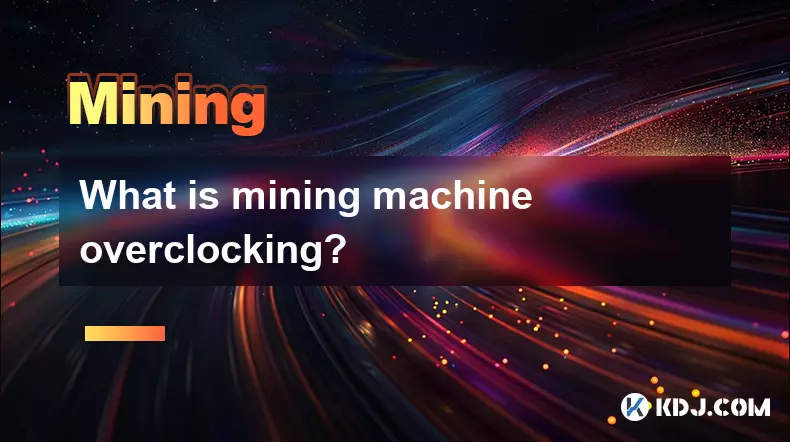-
 bitcoin
bitcoin $122025.899241 USD
-2.12% -
 ethereum
ethereum $4488.068729 USD
-4.11% -
 bnb
bnb $1315.348019 USD
8.65% -
 tether
tether $1.000457 USD
0.03% -
 xrp
xrp $2.875326 USD
-3.69% -
 solana
solana $222.043604 USD
-4.07% -
 usd-coin
usd-coin $0.999682 USD
0.00% -
 dogecoin
dogecoin $0.249887 USD
-5.62% -
 tron
tron $0.337379 USD
-2.59% -
 cardano
cardano $0.827763 USD
-5.06% -
 hyperliquid
hyperliquid $45.774531 USD
-2.43% -
 chainlink
chainlink $22.079309 USD
-5.87% -
 ethena-usde
ethena-usde $1.000156 USD
0.02% -
 sui
sui $3.482566 USD
-3.57% -
 stellar
stellar $0.386982 USD
-4.92%
What is the best CPU for mining Monero?
High-performance CPUs with large L3 cache and multi-threading, like the AMD Ryzen 9 5950X or Intel Core i9-12900K, are ideal for Monero mining due to the RandomX algorithm's memory-intensive nature.
Jul 27, 2025 at 12:07 pm

Understanding the Role of CPU in Monero Mining
Monero (XMR) is a privacy-focused cryptocurrency that utilizes the RandomX algorithm, which is specifically designed to be CPU-friendly and resistant to ASIC and GPU mining. This makes high-performance CPUs the primary choice for mining XMR. Unlike other cryptocurrencies that rely heavily on graphics cards or specialized hardware, Monero’s RandomX algorithm emphasizes memory-intensive operations, favoring processors with large cache sizes and multi-threading capabilities.
The efficiency of your mining operation largely depends on the hash rate your CPU can achieve while maintaining low power consumption. The ideal CPU for Monero mining should balance these factors without overheating or requiring excessive cooling infrastructure.
Key Features to Look For in a Monero Mining CPU
When selecting a CPU for mining Monero, several technical aspects must be considered to ensure optimal performance:
- Large L3 Cache: The RandomX algorithm benefits significantly from larger L3 cache sizes, as it stores temporary data during hashing operations.
- Multi-threading Support: CPUs with SMT (Simultaneous Multi-Threading) or Hyper-Threading allow more threads to run concurrently, improving overall hash rate.
- Memory Bandwidth: High-speed RAM compatibility (e.g., DDR4 3200MHz or higher) ensures faster data access, crucial for RandomX performance.
- Thermal Design Power (TDP): Lower TDP CPUs are preferred for mining rigs due to their energy efficiency, especially when operating multiple units simultaneously.
- Socket Compatibility: Ensure the motherboard supports ECC memory, which is recommended for stability in long-running mining tasks.
These characteristics help narrow down the best-performing CPUs for Monero mining, allowing miners to maximize output while minimizing costs.
Top CPUs for Mining Monero in 2024
Several CPUs stand out due to their performance in real-world Monero mining scenarios:
- AMD Ryzen 9 5950X: With 16 cores and 32 threads, this processor delivers an average hashrate of 7000–8000 H/s under optimal conditions. Its large L3 cache (64MB) and support for DDR4 3200MHz RAM make it one of the most efficient choices.
- Intel Core i9-12900K: Offering 16 cores (8P + 8E) and 24 threads, this CPU provides a hashrate of around 6000–6500 H/s. It's known for its low latency memory access, which helps boost RandomX performance.
- AMD EPYC 7551P: Designed for servers, this processor features 32 cores and 64 threads, delivering up to 12,000 H/s. It’s ideal for large-scale mining farms but requires compatible server motherboards and ECC RAM.
- Intel Xeon Gold 6248R: A powerful server-grade CPU with 24 cores and 48 threads, achieving approximately 9500 H/s. It excels in multi-CPU setups due to its scalable architecture and support for high-capacity RAM.
Each of these CPUs offers unique advantages depending on the scale and setup of your mining operation.
Step-by-Step Guide to Setting Up a CPU for Monero Mining
To begin mining Monero using a CPU, follow these detailed steps:
- Choose a mining pool such as MoneroOcean, MineXMR, or PoolXMR.
- Create a wallet address using services like Monero GUI Wallet, CLI Wallet, or hardware wallets like Ledger.
- Download a RandomX-compatible miner, such as XMRig or XMRigCC.
- Extract the downloaded files into a dedicated folder, preferably on an SSD for faster access.
- Edit the configuration file (usually config.json) to include your pool address, wallet address, and worker name.
- Adjust advanced settings like CPU affinity, thread count, and cache optimization for better performance.
- Run the miner executable and monitor the console output for any errors or warnings.
- Use tools like HWiNFO or Core Temp to track CPU temperature and utilization during mining.
Ensure that your BIOS settings prioritize performance mode, disable unnecessary background applications, and allocate sufficient RAM to avoid throttling.
Optimizing CPU Performance for Monero Mining
Maximizing the efficiency of your mining rig involves fine-tuning both software and hardware components:
- Enable XMP/DOCP profiles in the BIOS to run RAM at its rated speed, enhancing memory bandwidth.
- Use lightweight operating systems like Ubuntu Server or Windows 10 LTSC to reduce overhead.
- Configure the miner to use huge pages for improved memory management, which can increase hashrate by up to 10%.
- Experiment with different CPU core affinities to prevent thermal throttling and uneven load distribution.
- Apply undervolting techniques to reduce power consumption without sacrificing performance.
- Monitor temperatures regularly and consider adding case fans or liquid cooling if sustained loads cause overheating.
These optimizations help maintain consistent performance over extended mining sessions and improve profitability per watt.
Frequently Asked Questions About CPU Mining for Monero
Q: Can I mine Monero using an older generation CPU?A: Yes, even CPUs from a few generations back can mine Monero effectively, though they will produce lower hashrates. For example, an Intel i5-8400 or AMD Ryzen 5 2600 can still yield between 1500–2500 H/s.
Q: Is it worth mining Monero with a single CPU at home?A: Mining solo with one CPU may not be profitable due to electricity costs and block variance. Joining a mining pool increases the chances of earning steady rewards, even with modest hardware.
Q: Do I need ECC RAM for Monero mining?A: While not mandatory, ECC (Error-Correcting Code) RAM is highly recommended for stability, especially in long-running mining environments where data integrity is crucial.
Q: How does CPU mining compare to GPU mining for Monero?A: Since Monero uses the RandomX algorithm, which is optimized for CPUs, GPU mining is not effective and yields negligible returns compared to modern multi-core CPUs.
Disclaimer:info@kdj.com
The information provided is not trading advice. kdj.com does not assume any responsibility for any investments made based on the information provided in this article. Cryptocurrencies are highly volatile and it is highly recommended that you invest with caution after thorough research!
If you believe that the content used on this website infringes your copyright, please contact us immediately (info@kdj.com) and we will delete it promptly.
- BlockDAG, DOGE, HYPE Sponsorship: Crypto Trends Shaping 2025
- 2025-10-01 00:25:13
- Deutsche Börse and Circle: A StableCoin Adoption Powerhouse in Europe
- 2025-10-01 00:25:13
- BlockDAG's Presale Buzz: Is It the Crypto to Watch in October 2025?
- 2025-10-01 00:30:13
- Bitcoin, Crypto, and IQ: When Genius Meets Digital Gold?
- 2025-10-01 00:30:13
- Stablecoins, American Innovation, and Wallet Tokens: The Next Frontier
- 2025-10-01 00:35:12
- NBU, Coins, and Crypto in Ukraine: A New Yorker's Take
- 2025-10-01 00:45:14
Related knowledge

The difference between staking and mining
Sep 24,2025 at 05:18am
Understanding Staking in the Cryptocurrency Ecosystem1. Staking involves holding funds in a cryptocurrency wallet to support the operations of a block...

How to participate in testnet mining?
Sep 22,2025 at 09:18am
Understanding Testnet Mining in the Crypto Ecosystem1. Testnet mining is a method used by blockchain developers to simulate real-world conditions on a...

How to dispose of abandoned mining machines?
Sep 19,2025 at 08:19pm
Assessing the Condition of Abandoned Mining Rigs1. Begin by inspecting each mining machine for visible damage, corrosion, or missing components. Machi...

How to identify high-quality mining pools?
Sep 21,2025 at 03:19pm
Reputation and Track Record1. A mining pool’s reputation is built over time through consistent performance and transparency. Pools that have operated ...

Advantages of decentralized mining pools
Sep 20,2025 at 04:36pm
Enhanced Security and Resistance to Censorship1. Decentralized mining pools operate on blockchain-based smart contracts, eliminating the need for a ce...

What is mining machine overclocking?
Sep 21,2025 at 07:19pm
Understanding Mining Machine Overclocking1. Mining machine overclocking refers to the process of increasing the operating frequency of a cryptocurrenc...

The difference between staking and mining
Sep 24,2025 at 05:18am
Understanding Staking in the Cryptocurrency Ecosystem1. Staking involves holding funds in a cryptocurrency wallet to support the operations of a block...

How to participate in testnet mining?
Sep 22,2025 at 09:18am
Understanding Testnet Mining in the Crypto Ecosystem1. Testnet mining is a method used by blockchain developers to simulate real-world conditions on a...

How to dispose of abandoned mining machines?
Sep 19,2025 at 08:19pm
Assessing the Condition of Abandoned Mining Rigs1. Begin by inspecting each mining machine for visible damage, corrosion, or missing components. Machi...

How to identify high-quality mining pools?
Sep 21,2025 at 03:19pm
Reputation and Track Record1. A mining pool’s reputation is built over time through consistent performance and transparency. Pools that have operated ...

Advantages of decentralized mining pools
Sep 20,2025 at 04:36pm
Enhanced Security and Resistance to Censorship1. Decentralized mining pools operate on blockchain-based smart contracts, eliminating the need for a ce...

What is mining machine overclocking?
Sep 21,2025 at 07:19pm
Understanding Mining Machine Overclocking1. Mining machine overclocking refers to the process of increasing the operating frequency of a cryptocurrenc...
See all articles










































































